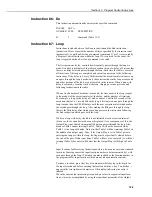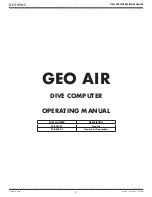
CR10X Reference Manual
12-10
A single parameter is used to select whether the instruction is to control the printer
or Storage Module output, and, if the printer is selected, the format and baud rate.
The instruction must be entered separately for each device that is to receive
output.
If both Final Storage areas are in use, Instruction 96 sends data from the area
which is currently active. Final Storage Area 1 is active at the start of each table.
Instruction 80 can be used to change the active area. The area set by Instruction
80 remains active until changed by another Instruction 80 or the table ends (at
which time Area 1 becomes the active area). Instruction 80 can also direct output
to Input Storage, in which case Instruction 96 assumes that Final Storage Area 1 is
the active area.
If the CR10X is already communicating via its serial I/O port when Instruction 96
is executed, the output request is put in a queue and program execution continues.
As the I/O port becomes available, each device in the queue is serviced in turn.
The request is not put in the queue if the same device is already in the queue. The
information contained in the queue (and which determines a unique entry) is the
baud rate (if applicable) and the Final Storage area. Instruction 98 (Send
Character) also uses this queue.
When an entry reaches the top of the queue, the CR10X sends all data accumu-
lated since the last transfer to the device up to the location of the DSP at the time
the device became active (this allows everything in the queue to get a turn even if
data is being stored faster than it can be transferred to a particular device).
The ‘other Final Storage Area’ device option (the non-active area) allows a ‘fast’
Final Storage area to be transferred to the main area on some trigger condition so
there is some history recorded before the trigger condition (see example in Section
8). The source of data is the currently active Final Storage Area, set by Instruction
80 (default = 0 or 1).
When the baud rate code specifying a checksum is used, the checksum of the data
is sent as the last piece of data in the data array. This only works when sending
comma delineated data. See Section 5.1 for more information about the
checksum.
All memory pointers are positioned to the DSP location when the
datalogger compiles a program. For this reason,
always retrieve
uncollected data before making program changes
.
PARAM.
DATA
NUMBER
TYPE
DESCRIPTION
01:
2 Device
Option
80 = To the other Final Storage Area (New data since the
last time)
81 = To the other Final Storage Area (The entire active
Final Storage Area)
(x) BAUD RATE CODES
0
300 baud
1
1200 baud
2
9600 baud
3
76800 baud
4
300 with checksum
5
1200 with checksum
6
9600 with checksum
7
76800 with checksum
CAUTION
















































